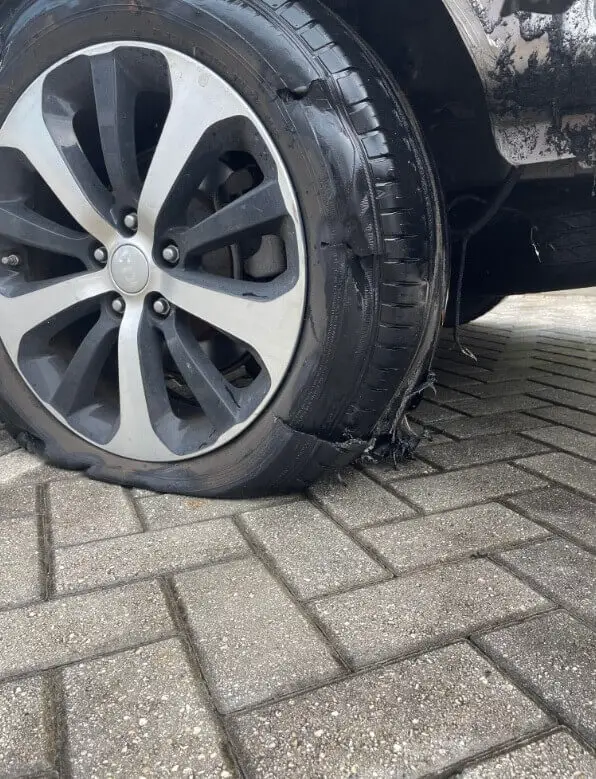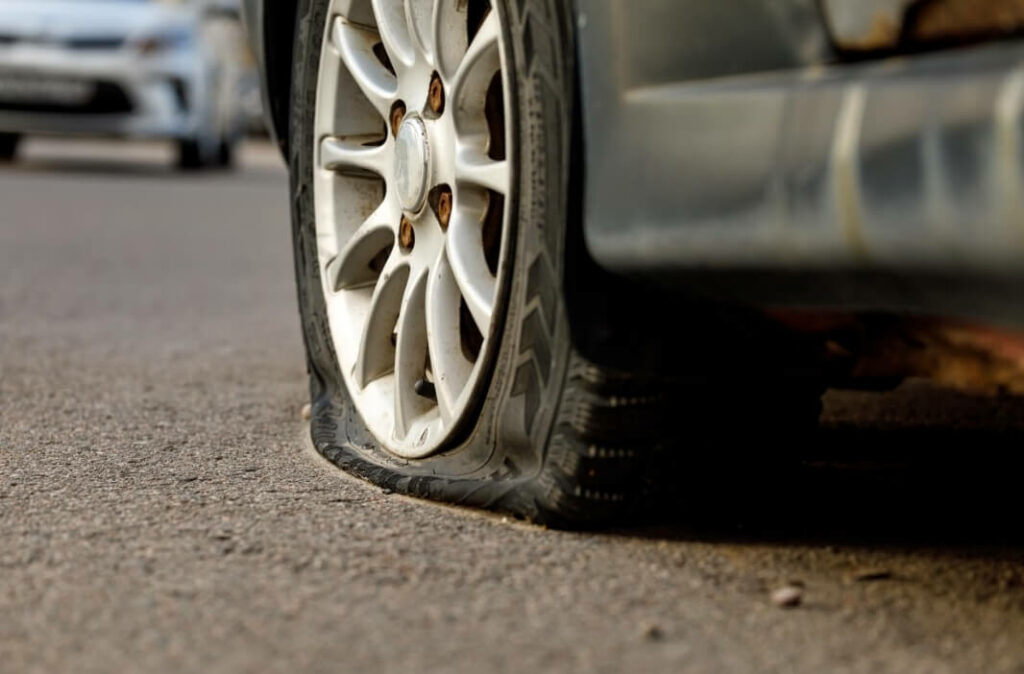Ever wondered, “What should you do if your tire suddenly blows out while driving?” It’s a situation no one wants to face, but being prepared can make all the difference. This guide will walk you through the immediate steps to ensure your safety in such daunting scenarios. Let’s dive in and arm ourselves with crucial knowledge to navigate this unexpected challenge.
Picture this: You’re driving along, taking in the peaceful ride, when disaster strikes – your tire blows out! Fear takes over as you struggle to manage your car. But don’t worry! This guide will tell you what to do when this happens.
Safety is of the utmost importance. As soon as your tire bursts, grip the steering wheel firmly. Do not slam on the brakes or make any sudden movements. Instead, reduce the speed gradually.

Once you have control, look for a place to park away from traffic. Use hazard lights and check your mirrors before changing lanes.
Stop and examine the tire. If it’s totally flat or really damaged, don’t try to repair it yourself. Call for help or find a professional mechanic.
Be prepared. Carry a spare tire, jack, lug wrench, and flashlight in case of emergencies. Check your tires regularly and keep them inflated.
Accidents happen, but staying calm helps. By following these steps and prioritizing safety, you can handle a blown-out tire while driving. Stay alert and drive carefully!
Understanding the signs of a tire blowout
Unexpected jolts? If you feel intense vibrations when gripping the steering wheel or sitting in the seat, it could mean a tire’s about to blow. Keep an eye out for any sudden changes in how your car moves. A loud bang, like an explosion, may also be a sign of a tire blowout.
Don’t panic – stay focused on steering the vehicle back under control. It can pull in an unexpected direction due to the blowout. These signs may differ, depending on the type of tire or road conditions. In any case, be aware of them to prepare for a possible blowout.
If you’re caught in one, take these steps:
- Keep calm and maintain control of the car.
- Don’t brake or jerk the wheel suddenly.
- Ease your foot off the accelerator with a firm grip on the wheel.
- Once you have the situation under control, move the car onto the side of the road.
These actions prioritize safety, prevent further damage, and stop other drivers from getting hurt. Keeping calm will help you think clearly and act without panicking. Gradually lifting off the accelerator reduces strain on the remaining tires and helps you get back in control. Finally, pulling off the road keeps you and other motorists secure.
By understanding the signs of a blowout and following these tips, you’ll be able to manage this potentially dangerous situation with confidence.
Do you know? Can You Plug a Run Flat Tire? Uncover the Truth!
What Should You Do If Your Tire Suddenly Blows Out While Driving?
Blowouts can be alarming and hazardous on the road. To guarantee your safety and that of others, here are some of the immediate steps to take when a tire blows out while driving:
- Stay cool-headed: When you recognize your tire has burst, don’t lose your temper. Having a fit won’t help. Breathe deeply and focus on what to do next.
- Hold the wheel tight: When the tire pops, you may feel your car lurch. Securely grab the wheel to keep control. Don’t make sudden moves or overcompensate with the steering wheel.
- Park carefully: As you decelerate, spot a safe spot on the side of the street. Signal your aim to pull over and drive cautiously to the parking area.
When things don’t go as planned, remain calm. You’ll make better decisions and manage the situation better.
Pro Tip: Keep an eye on your tires and ensure they have the right air pressure to minimize blowout risks.
Assessing the damage
To assess the damage, here’s a helpful table:
| Factor | Significance |
|---|---|
| Tire Condition | Was it worn-out or punctured? |
| Vehicle Control | Did you maintain control during the incident? |
| Road Conditions | How did the road add to the blowout? |
| Damage Extent | What damage to the tire and surroundings? |
This’ll help you understand the situation and decide next steps.
Unique details like sounds or sensations before or after the blowout should be remembered. This can be useful when talking to a professional or insurance provider.

A driver ignored a minor blowout, only to find out the tire had serious internal damage afterwards. This shows why assessing damage after a tire blowout is important.
Act quickly and evaluate the impact of a tire blowout. That way, you can stay safe and avoid long-term issues for yourself and your vehicle.
Must check: Can You Drive on a Flat Tire in an Emergency? Here’s What Experts Say
Taking necessary actions after the blowout
Encountering a tire blowout while driving can be jolting. To safeguard your security and lessen any possible harm, take after these five key strides:
- Keep a firm hold on the guiding wheel to keep up control of your vehicle.
- Try not to brake all of a sudden, as this can bring about further instability. Rather, step by step discharge the quickening agent.
- Gently guide in the inverse heading to where the blowout happened, permitting your auto to back off and securely stop on the side of the street.
- Turn on your peril lights to alarm different drivers of your circumstance.
- Once stopped, survey the state of the harmed tire and contact proficient help if necessary.
Remember that being arranged is vital in circumstances like these. Consistently checking your tires’ pressure, track profundity, and general condition can help anticipate blowouts.
Besides these significant advances, it is basic to remain quiet and composed all through this unanticipated occasion. Overreacting or making startling developments may further bargain your security.
Pro Tip: It is constantly prescribed to convey an emergency unit in your vehicle with fundamental things, for example, a jack, extra tire, lug wrench, electric lamp, and intelligent cautioning sign for included accommodation during tire crises.
By following these guidelines and remaining calm-headed during a tire blowout episode, you can viably deal with this unforeseen circumstance while prioritizing safety for yourself and others out and about.
Preventive measures to avoid tire blowouts
It’s essential to keep your tires in top condition and take preventive measures to avoid blowouts.
Here are some tips to keep your tires in good shape:
- Check tire pressure and inspect for signs of wear and tear regularly.
- Rotate tires to even out wear.
- Don’t overload your car beyond its capacity.
- Drive at a moderate speed and take breaks during long trips.
My friend Jake had an incident with a tire blowout while speeding down the highway. He handled it well, but it was a reminder of how vital these precautions are.

Heed this advice for safe travels – inspect and maintain your tires properly. That way, you’ll be ready for anything and stay safe on the roads!
Final Thoughts on What to Do If Your Tire Suddenly Blows Out While Driving
If your tire suddenly blows out while driving, stay calm and take action! Grip the wheel with both hands and let go of the accelerator. Avoid braking suddenly to prevent skidding. Maneuver your vehicle to the side and turn on hazard lights. Stop in a safe spot and check the damage. Call for help if needed.
Prevention is key when it comes to tire blowouts. Check your tires for any bulges or cuts in the sidewall. Maintain proper tire pressure by checking it at least once a month. Avoid overloading your vehicle beyond its weight capacity to avoid straining the tires.
Knowing how to change a tire safely and efficiently is important. Read the vehicle manual or watch online tutorials. Keep essential tools like a spare tire, jack, lug wrench, and flashlight in your car. Practice changing a tire in a controlled environment.
Safety should always be your priority. Follow these guidelines and be prepared. According to AAA, 220 million flat tires occur on US roads each year.
FAQs on What Should You Do If Your Tire Suddenly Blows Out:
Driving can present unexpected challenges, and one of the most daunting is experiencing a tire blowout. Naturally, many drivers wonder about the root causes and immediate steps to take in such situations. In this section, we’ll address these pressing concerns.
Dive into the answers to frequently asked questions on what causes tire blowouts, what to do when your tire blows out, and the recommended actions to take if a tire blows out. Equip yourself with the knowledge to stay safe and react effectively.
Q: What should I do if my tire blows out while driving?
A: If your tire blows out while driving, remain calm and avoid panicking. Hold the steering wheel firmly and gradually ease off the accelerator. Do not slam the brakes or make sudden steering movements. Maintain a straight line and gradually slow down before carefully pulling off to the side of the road.
Q: Should I try to change the tire myself?
A: It is generally recommended to call for professional help or roadside assistance to change the tire safely. If you are experienced and feel confident in changing the tire yourself, ensure you have a spare tire, car jack, and all necessary tools. Safety should be your utmost priority.
Q: What if I don’t have a spare tire?
A: If you don’t have a spare tire, make sure you have a roadside assistance plan or contact a towing service. It is important not to drive on a blown-out tire, as it can cause further damage to your vehicle and compromise your safety on the road.
Q: Can I still drive on a flat tire?
A: It is not safe to drive on a flat tire. The lack of air pressure can cause further damage to the tire itself and possibly to the vehicle’s rim. Driving on a flat tire can also increase the risk of losing control of the vehicle, especially at higher speeds.
Q: How often should I check my tire pressure?
A: It is advisable to check your tire pressure at least once a month. Fluctuations in weather and temperature can affect tire pressure, so maintaining the recommended tire pressure helps optimize fuel efficiency, tire lifespan, and overall safety on the road.
Q: Can I prevent tire blowouts?
A: While tire blowouts can occur unexpectedly, regular tire maintenance can help prevent them. Make sure to regularly inspect your tires for signs of wear and tear, maintain proper tire pressure, and rotate your tires according to the manufacturer’s recommendations. Additionally, avoid overloading your vehicle and driving over potholes or curbs whenever possible.
You might want to explore: